It’s not uncommon to log into a WIRED Zoom and find two or three pairs of Grado over-ear headphones staring back at you. We’ve called them “the best headphones in the world,” after all. Not only is the sound quality top-tier, but they’re also beautiful and have a storied history. Grado Labs is a family-run company that has made all its headphones by hand in the same Brooklyn factory since 1953.
I was excited to test its first pair of wirefree buds, but a little nervous too. We’ve tested a lot of wireless earbuds, and in general, I’d say you mostly pick these kinds of earbuds for their convenience rather than sound quality. They’re small and easy to lose, and the Bluetooth connection can be janky. There’s a reason why our top pick is only around $100.
I shouldn’t have worried. The Grado GT220 are expensive—and for the price, they may not have many of the features I’ve come to love about many wirefree buds. But they sound wonderful, are beautiful, and feel more secure than any bud I’ve tried that doesn’t have an optional ear fin or wing included. If you love great sound and have been generally disappointed by the wireless earbuds you’ve tried, these will probably work for you.
The first thing you’ll note about the GT220 is the case. It’s quite a bit taller and longer than the AirPods Pro or Samsung Galaxy Buds Live case, but it’s a beautiful, smooth matte black that makes small, overly shiny cases look garish. Inside, the buds look fairly standard. They’re also matte black, flat, and have no visible buttons—just a glowing Grado logo that turns on when you open the case.
Fitting earbuds is something of a chore. I have small, shallow ears, so I usually have to spend a lot of time experimenting with different sizes and materials of earbud tips to find one that will both feel secure in the hollow of my ear and also seal properly against my ear canal. And, of course, fit can affect sound quality.
With the Grado GT220, the smallest earbud tip fit perfectly. It extended farther down into my ear, and it sealed perfectly against my ear canal when I gave it a final gentle twist. The buds might not have active noise-canceling properties, but passive noise cancellation works pretty well when the fit is that good. A pair of foam earplugs doesn’t need any advanced software either. Noise canceling worked well enough for a repair person to startle me as I was working (masked) at my desk.
I’ve also complained before about needing a full manual and a day to memorize all the different ways you have to hold and tap buttons to manipulate wirefree earbuds, like you’re tapping out Morse code to communicate with the manufacturer. "Oh, it’s simple!" the instructions always say. "Just hold and tap three times for transparency, double-tap for volume, hold to take the call!" I recite these to myself as I walk around, along with a constant litany of "No! Ack! Dammit, sorry I hung up on you!"

